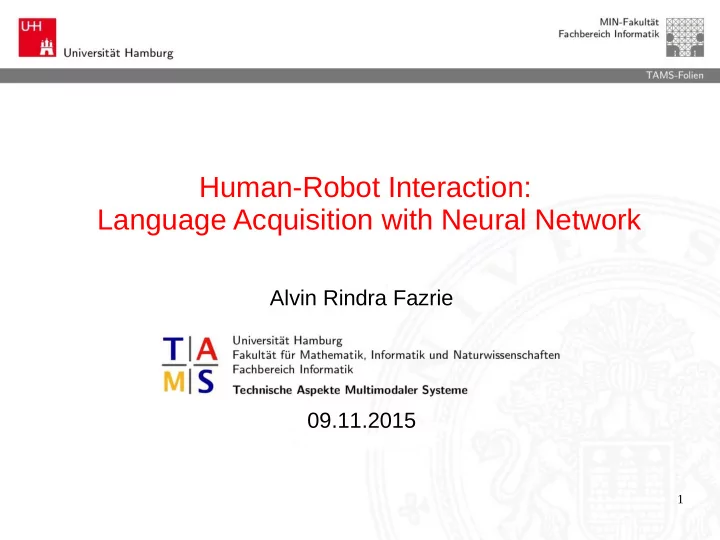

Human-Robot Interaction: Language Acquisition with Neural Network Alvin Rindra Fazrie 09.11.2015 1
Outline ● Motivation ● Basics and Definitions - Natural Language Processing - Neural Network ● Neural Network Architecture - Single Layer Feed Forward Networks - Multi-Layer Feed Forward Networks - Recurrent Neural Networks - Echo State Network ● Stochastic Learning Grammar ● Conclusion 2
Motivation Understanding and generating humans’ natural language, it might be feasible in the future to address computers like humans. 3
Natural Language Processing ● To analyze, understand and generate languages, that are used by humans. ● The structure of words (syntactic) - Part Of Speech tagging (POS) - Chunking - Syntactic Parser (PSG) ● Semantic Information - Named Entity Recognition (NER) - Semantic Role Labeling (SRL) - Word-sense Disambiguation 4
Neural Network ● Biologically inspired statistical learning algorithms 5 Picture 1. based on [HAY94]
Architecture Single-Layer FeedForward Networks[1] Multi-Layer FeedForward Networks[2] Picture 2. based on [1]http://hubpages.com/technology/Artificial-Neural-Network 6 Picture 3. based on [2] http://www.codeproject.com/Articles/175777/Financial-predictor-via-neural-network
Architecture Recurrent Neural Network[3] Echo State Network[4] Picture 4. based on [3] https://en.wikibooks.org/wiki/Artificial_Neural_Networks/Recurrent_Networks Picture 5. based on [4] H. Jaeger (2007):Echo State Networks.Scholarpedia, 2(9):2330,2007. 7
Neural Production Model for Scene Description Task 8 Picture 6. based on http://www.ncbi.nlm.nih.gov/pmc/articles/PMC4018555/
Stochastic Learning Grammar (SLG) 9 Picture 7. Based on [MAR15]
Dialogic Syntactic Language Game 10 Picture 8. Based on [MAR15]
Conclusion ● Natural Language Processing addresses computers to be like human in the future. ● Neural Network approaches are key concepts of Language Acquisition between Human-Robot Interaction ● SLG and ESN has a possibility to be integrated. 11
Literature [HAY94] Haykin, Simon, 1994, “Neural Networks: A Comprehensive Foundation”. Macmillian Publishing Company: New York. [HIN14] Hinaut, X., Petit, M., Pointeau, G., & Dominey, P. F. (2014). Exploring the acquisition and production of grammatical constructions through human-robot interaction with echo state networks.Frontiers in neurorobotics,8. http://www.ncbi.nlm.nih.gov/pmc/articles/PMC4018555/ [MAR15] Darío Maravall, Jack Mario Mingo, Javier De Lope, Alignment in vision-based syntactic language games for teams ofrobots using stochastic regular grammars and reinforcement learning: The fully autonomous case and the human supervised case, Robotics and Autonomous Systems, Volume 63, Part 2, January 2015, Pages 180-186, ISSN 0921-8890, http://dx.doi.org/10.1016/j.robot.2014.09.013. [LUK12] M. Lukoševičius (2012):A Practical Guide to Applying Echo State Networks.In: G. Montavon, G. B. Orr, and K.-R. Müller (eds.) Neural Networks: Tricks of the Trade, 2nd ed. Springer LNCS 7700, pp 659-686 [JAE07] H. Jaeger (2007):Echo State Networks.Scholarpedia, 2(9):2330,2007. 12
Recommend
More recommend